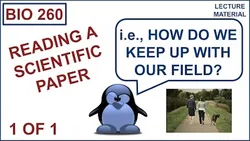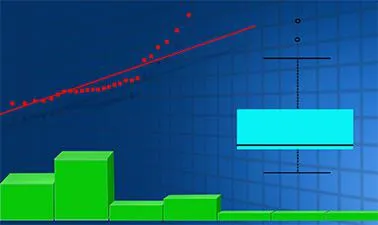
Bio 260 (biostatistics) 
This course covers the advanced statistical techniques of reading a scientific paper, designing metrics, and two-factor ANOVA (two-way ANOVA). Examples and worked examples are provided to help students understand the concepts. The course also introduces the use of software for data analysis. ▼
ADVERTISEMENT
Course Feature
![]() Cost:
Cost:
Free
![]() Provider:
Provider:
Youtube
![]() Certificate:
Certificate:
Paid Certification
![]() Language:
Language:
English
![]() Start Date:
Start Date:
On-Demand
Course Overview
❗The content presented here is sourced directly from Youtube platform. For comprehensive course details, including enrollment information, simply click on the 'Go to class' link on our website.
Updated in [February 21st, 2023]
What does this course tell?
(Please note that the following overview content is from the original platform)
Reading a scientific paper.
Advanced Statistics: a tour of some techniques.
Designing Metrics.
Two-factor ANOVA (two-way ANOVA): Examples.
Two-factor ANOVA (two-way ANOVA): Worked examples.
Two-factor ANOVA (two-way ANOVA): Introduction.
One-factor ANOVA (one-way ANOVA): Transformations.
Visual display (4): The bad, manipulative, and the good.
Visual display (3): general advice.
Visual display (2): adding information.
Visual display(1): introduction.
Experimental design: Two important studies.
Experimental design: FDA testing.
Experimental design: sources of bias.
Chi-squared test: tests of independence.
Chi-squared test: goodness of fit test.
We consider the value of this course from multiple aspects, and finally summarize it for you from three aspects: personal skills, career development, and further study:
(Kindly be aware that our content is optimized by AI tools while also undergoing moderation carefully from our editorial staff.)
1. You can learn how to read a scientific paper and understand the content. You can also learn how to use advanced statistics to analyze data and design metrics.
2. You can learn how to use two-factor ANOVA (two-way ANOVA) to analyze data, including examples and worked examples. You can also learn how to use one-factor ANOVA (one-way ANOVA) and transformations.
3. You can learn how to create visual displays, including the bad, manipulative, and the good. You can also learn general advice for adding information to visual displays.
4. You can learn how to design experiments, including two important studies, FDA testing, and sources of bias. You can also learn how to use the Chi-squared test to test for independence and goodness of fit.
[Applications]
Those who have completed Bio 260 (biostatistics) can apply their knowledge to a variety of areas. They can use the skills they have learned to read scientific papers, design metrics, and analyze data using two-factor ANOVA (two-way ANOVA) and one-factor ANOVA (one-way ANOVA). They can also use the techniques they have learned to create visual displays and design experiments. Finally, they can use the chi-squared test to test for independence and goodness of fit.
[Career Paths]
1. Biostatistician: Biostatisticians use their knowledge of statistics and mathematics to analyze data and develop models to help inform decisions in the medical and health fields. They are responsible for designing and conducting experiments, analyzing data, and interpreting results. As the healthcare industry continues to grow, the demand for biostatisticians is expected to increase.
2. Data Scientist: Data scientists use their knowledge of statistics, mathematics, and computer science to analyze large datasets and develop models to help inform decisions in a variety of industries. They are responsible for collecting, cleaning, and analyzing data, developing predictive models, and interpreting results. As the need for data-driven decision making increases, the demand for data scientists is expected to grow.
3. Epidemiologist: Epidemiologists use their knowledge of statistics and mathematics to study the causes and effects of diseases and other health-related issues. They are responsible for designing and conducting studies, analyzing data, and interpreting results. As the need for public health research increases, the demand for epidemiologists is expected to grow.
4. Research Analyst: Research analysts use their knowledge of statistics and mathematics to analyze data and develop models to help inform decisions in a variety of industries. They are responsible for collecting, cleaning, and analyzing data, developing predictive models, and interpreting results. As the need for data-driven decision making increases, the demand for research analysts is expected to grow.
Course Provider

Provider Youtube's Stats at AZClass
Over 100+ Best Educational YouTube Channels in 2023.
Best educational YouTube channels for college students, including Crash Course, Khan Academy, etc.
AZ Class hope that this free Youtube course can help your Biostatistics skills no matter in career or in further education. Even if you are only slightly interested, you can take Bio 260 (biostatistics) course with confidence!
Discussion and Reviews
0.0 (Based on 0 reviews)
Explore Similar Online Courses

99 problems - GCSE Higher revision

ArcGIS Maps for Adobe Creative Cloud

Python for Informatics: Exploring Information

Social Network Analysis

Introduction to Systematic Review and Meta-Analysis

The Analytics Edge

DCO042 - Python For Informatics

Causal Diagrams: Draw Your Assumptions Before Your Conclusions

Whole genome sequencing of bacterial genomes - tools and applications

Doing Clinical Research: Biostatistics with the Wolfram Language

Introduction to Applied Biostatistics: Statistics for Medical Research


Start your review of Bio 260 (biostatistics)